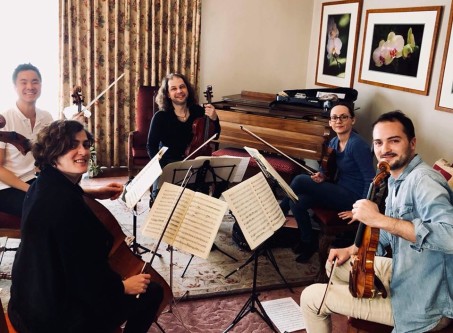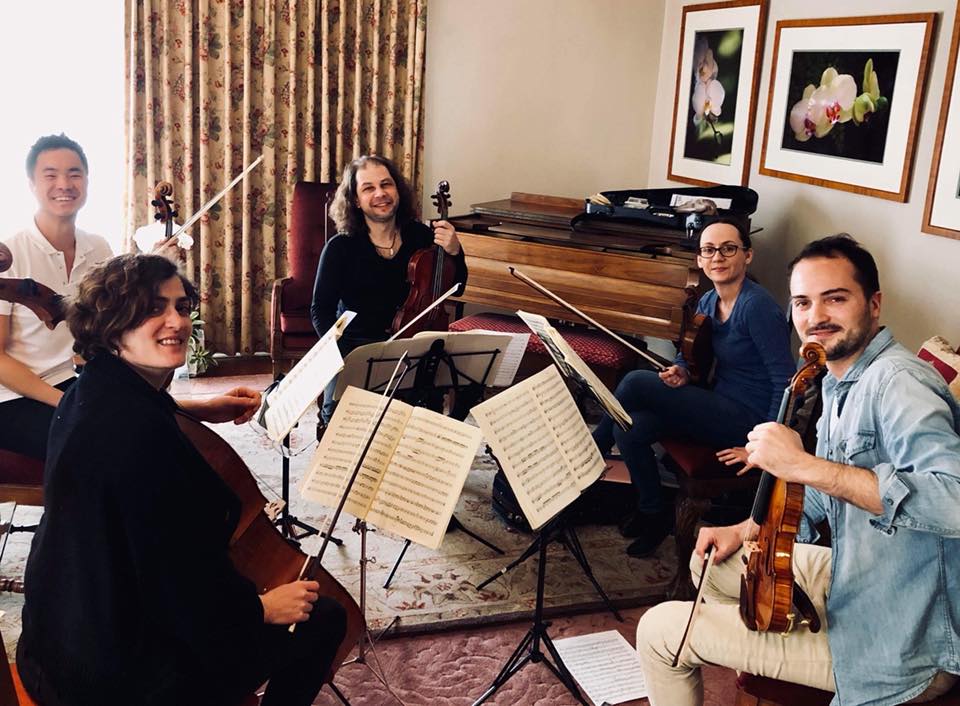 Canada Mozart: Szymanowski Quartet [Agata Szymczewska and Robert Kowalski (violins), Volodia Mykytka (viola), Monika Leskovar (cello)] with Richard O’Neill (second viola), Vancouver Playhouse, Vancouver, 18 and 20.2.2018. (GN)
Canada Mozart: Szymanowski Quartet [Agata Szymczewska and Robert Kowalski (violins), Volodia Mykytka (viola), Monika Leskovar (cello)] with Richard O’Neill (second viola), Vancouver Playhouse, Vancouver, 18 and 20.2.2018. (GN)

Mozart – The Six String Quintets
It has been many years since the complete Mozart String Quintets have been performed here, and this traversal by the Szymanowski Quartet was especially rewarding. One recalls several fine concerts from these artists in the romantic repertoire, but only Haydn among the earlier masters. The current interest in Mozart likely follows from the quartet’s recent change in membership and the need to reconsolidate repertoire and performance standards by a return to ‘the classics’. The quartet’s warm, burnished sound, transparency in voicings and structural awareness remain as conspicuous as before, and these are certainly attributes that can be put to good work in Mozart. Playing the six string quintets together is nonetheless a major challenge: the works have almost unrivalled diversity and depth – for many, they constitute the most sublime reaches of the composer’s art – and demand unflagging concentration. Overall, the Szymanowski’s traversal found many instances of great beauty and insight, mining the rich diversity in the constructions and putting the finishing touch on the cycle with a strong reading of the heavenly G minor Quintet.
It is of some interest that the reconstitution of this Polish ensemble began in 2014 when first violinist Agata Szymczewska arrived. Robert Kowalski then joined as the second violin while cellist Monika Leskovar came on board six months ago, leaving wonderful-toned violist Volodia Mykytka as the only original member. Many string quartets have changed their personnel by one or two players slowly over time but changing three players in three years is a formidable adjustment. For these quintets, the ensemble was joined by estimable second violist Richard O’Neill, a member of the Ehnes Quartet.
In spite of the relative unfamiliarity of the players, one ingredient in the success of these performances was just how well each of the two violins and violas managed to work together, finding strong interactions in and between their voices, as set on top of Leskovar’s anchoring cello. The style of the playing was generally deliberative and patiently detailed, contrasting with some of the urgent and quicksilver interpretations of the past. There was also a degree of rustic colour present, in both accents and nuance. The sense of patience reminded me somewhat of the Chilingirian Quartet and their fine traversals of Mozart years ago; the accents and colour possibly recall the Talich Quartet’s esteemed integral recording. Throughout, the group’s apparent challenge was to open out enough interpretative space to register full detail and instrumental conversation while not compromising the music’s natural motion and inevitability.
Mozart’s 6 String Quintets cover his entire compositional span, starting with the B flat major Quintet K.174, written when he was 17, to the E flat major Quintet K.614, written in the last year of his life. The two were paired as the opening works of the first concert and received very convincing readings. A more spacious approach to the former certainly augmented its usual ‘divertimenti’ outlines: there was added structural weight and detailing throughout and more emotional depth in the Adagio in particular. But, always, it was the beautiful timbres, the suspending ostinatos and the underlying fluidity of expression that carried this approach. The rhythmic cogency and colour of K.614 was equally inspiring: the counterpoint was judiciously exposed, with a consistently rewarding balance between the voices. This was playing of real character: the tonal strength and leadership abilities of first violin Agata Szymczewska were always on display, as were the colour and sinew of the two violists, Mykytka and O’Neill.
The first of the ‘great’ string quintets, K.515 in C major, closed this concert, and it presented more of a challenge. The deliberate tempo for the long opening allegro again allowed probing detail and fine shading, but there was a methodical feel and less sense of spontaneity. With the exposition repeat observed, and not many variations in emotional intensity over its contours, this movement ended up a little long-winded. The playing in the following movements had appealing fluidity and tonal luster yet still erred on the cautious side, not quite finding a confident natural line or digging fully into its moments of intimacy. The fulsomeness of expression in the Andante seemed slightly misplaced, while a feeling of determination rather than burgeoning joy permeated the finale. This reading could work to a sharper focus.
The second concert opened with the tempestuous C minor Quintet K.406, and the Szymanowski Quartet certainly dug into its minor key intimations to give a romantic, almost Schubertian, reading. By all standards, this was a thoughtful and beautiful account, deeply felt, full of subtle allusions and dramatic narrative. On its own terms, it was quite eye-opening in what it probed, and unusually sensual in the way some of the instrumental timbres were explored. Nonetheless, the slow speed could be considered controversial: some might prefer the work to mimic the (typically) athletic pace of its companion version, the Wind Serenade K.388.
The performance of the penultimate D major Quintet K.593 was not as distinctive, and did not have the finely-honed finish of its companion, K.614. Fortunately, the most of exalted piece of them all, the G minor Quintet K.516, brought everything home in fine form: a judicious tempo for its famous opening Allegro, wonderful feeling and suspension in the final Adagio, followed by uplifting spring and purpose in the closing Allegro. The only thing one might have asked for was a slightly greater sense of intimacy in the Andante.
These two concerts were a wonderful treat – and a remarkable success for a reconstituted ensemble that is still getting up to speed. The Szymanowski’s interpretations tend to the broad and sometimes romantic side – which may be too ‘big’ for some tastes. Nonetheless, in those readings which stand as the group’s most finished products (and I would count four out of the six quintets performed here in that category), one would be hard-pressed to find playing of greater thoughtfulness and tonal beauty.
Geoffrey Newman
Previously published in a slightly different form on http://www.vanclassicalmusic.com.
